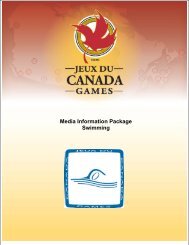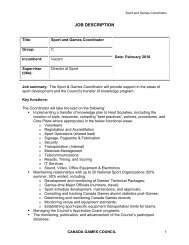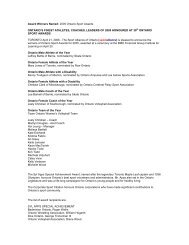Targets for Athlete Performance and the Sport System
Targets for Athlete Performance and the Sport System
Targets for Athlete Performance and the Sport System
Create successful ePaper yourself
Turn your PDF publications into a flip-book with our unique Google optimized e-Paper software.
The Australian experience, since its poor showing in Montreal 1976 to its outst<strong>and</strong>ing<br />
per<strong>for</strong>mance in Sydney 2000, is a notable model. Figure 9 highlights Australia’s Olympic<br />
per<strong>for</strong>mance over <strong>the</strong> past 4 decades, while Figure 10 shows <strong>the</strong> Australian federal government’s<br />
investment since 1976.<br />
Significant funding increases to<br />
sport that were initiated as a direct result<br />
of <strong>the</strong> poor per<strong>for</strong>mance at <strong>the</strong> 1976<br />
Games in Montreal lead to better<br />
per<strong>for</strong>mances at <strong>the</strong> 1984 <strong>and</strong> 1988<br />
Games. This was followed by a second<br />
round of funding increases in 1993 after<br />
Australia was awarded <strong>the</strong> hosting of <strong>the</strong><br />
2002 Games in Sydney. The funding was<br />
targeted to a core of 8 sports (Athletics,<br />
Basketball, Canoeing, Cycling,<br />
Gymnastics, Field Hockey, Rowing,<br />
Swimming), which produced 102 of <strong>the</strong><br />
140 (72.8%) Olympic medals won from<br />
1988 to 2000. Up to 50 sports may<br />
receive limited support from <strong>the</strong><br />
Australian <strong>Sport</strong> Commission, <strong>the</strong><br />
organization responsible <strong>for</strong> allocating <strong>the</strong><br />
federal contribution to sport. Most of <strong>the</strong><br />
funding is targeted on <strong>the</strong> core sports <strong>and</strong><br />
<strong>the</strong>re is very little attempt to support<br />
winter sports in Australia. A similar<br />
targeted approach is currently being<br />
undertaken in <strong>the</strong> U.K. (U.K. 2002).<br />
Figure 9: Australian Summer Olympic Per<strong>for</strong>mance<br />
60<br />
50<br />
40<br />
30<br />
20<br />
10<br />
0<br />
Australian Summer Olympic Medals<br />
Gold<br />
Silver<br />
Bronze<br />
1956 1960 1964 1968 1972 1976 1980 1984 1988 1992 1996 2000<br />
Olympiad<br />
Figure 10: Australian Funding <strong>for</strong> Olympic <strong>Sport</strong><br />
Ano<strong>the</strong>r measure of efficiency that<br />
might be of interest, especially <strong>for</strong><br />
governments that invest in sport, is a<br />
measure of return on investment,<br />
expressed as medals won per dollar<br />
invested, or <strong>the</strong> investment of dollars<br />
required to win an Olympic medal. For example, Australia invested a total of $1,211 million AUS<br />
$ in high per<strong>for</strong>mance sport from 1976-2000. The estimated cost per medal won from 1980-1996<br />
being about $8 million AUS $ (Hogan & Norton, 2001).<br />
This type of measure is problematic <strong>for</strong> a few reasons. First, it is difficult to measure <strong>and</strong><br />
compare <strong>the</strong> real investment in sport across nations because <strong>the</strong>re are many different funding<br />
partners, levels of government, government departments, <strong>and</strong> <strong>the</strong> private sector that invest in sport,<br />
making it difficult to obtain a measure that reflects <strong>the</strong> true investment. The comparison of national<br />
accounts or budget line items is over simplistic <strong>and</strong> often results in a comparison of apples to<br />
oranges, which provides little insight. Fur<strong>the</strong>rmore, different nations might fund sport through very<br />
different channels. For example, facilities used by many high per<strong>for</strong>mance athletes in <strong>the</strong> U.S. are<br />
built, maintained <strong>and</strong> operated by colleges <strong>and</strong> universities, while municipalities are a more<br />
<strong>Athlete</strong> Per<strong>for</strong>mance <strong>and</strong> <strong>Sport</strong> <strong>System</strong> <strong>Targets</strong>, Evaluation, <strong>and</strong> Investment Page 10





